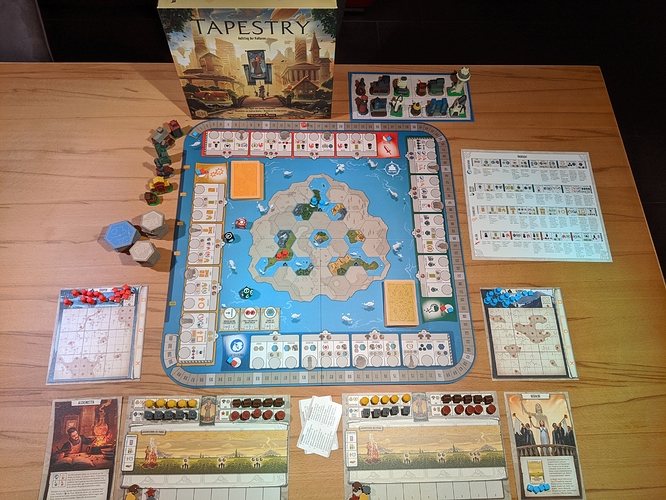Dragon Castle, a great looking game we should play more of. You have all the tiles stacked up on the main board. On your turn, you take one tile from the top stack, then another matching tile from anywhere else (as long as one of its long edges are free). Then you place them on your own board, trying to make up a single group of a colour. The more tiles in the group, the more points you score. You’re also trying to place pagodas for points at the end of the game. Its a very easy game to learn.
Quirky Circuits, things getting a bit tricky now, trying to pickup and deliver seed pods. We failed…
Nova Luna, enjoying this a lot still. Would have been a worthy winner of the SdJ (and was my choice).
Byzanz, first play of this small box game. Basically, its all about auctions, and I love a good auction game, so it was a winner. With 3 players, you have 3 auctions per round, one with 6 cards, then 4, then only 2. You bid on each auction, and if you win, the cards you bid go into the market, and the auction cards go into your hand. What you’re trying to do is make sets of 3 cards of the same goods type. You keep the highest of the group for scoring, and the other two cards are discarded. So if you had a set of 4,2 and 1 – you would score 4 victory points. After all the auctions, each player gets a chance to take all the cards of a goods type from the market. Its a pretty quick game, there are lots of goods cards, but you going thru them pretty quickly. I really enjoyed it, was pretty easy to pick up, but had some interesting decisions to make.
Snow Time, first play. Another small box game with some interesting game play. The game board is a tree with 7 levels. At the start of each round you roll 2 dice to see which levels get a fruit. Each player has the same cards: character cards from 1 to 7, and three special cards: The Healer, the Watcher, and the Blizzard. Each player picks a card, and then you all reveal at the same time. If you picked the same character card as someone else – you both lose. If you pick a level above another player, you’ll fight them and make them fall out of the tree (and you’ll get points). After all that – if you finish on a level with fruit, you’ll grab them and score points. if you fell out of the tree – you lose that card (but you can get it back). The special cards let you get discarded card back to your hand (Healer), play a card after others have chosen (Watcher), and discard any character cards played (Blizzard). The Watcher and Blizzard cards are one use only. Its not a long game. The score track is a little odd, you can get bonus points if you land on bonus places, and if you gained points of the correct type (points can be gained by fruit, fighting, and mana). I actually quite enjoyed it, it doesnt outstay its welcome. It could probably use an extra player (from our 3p).
The Crew
Pictures, the SdJ winner gets another go! A relatively high scoring game (of the few we’ve played). We had two rounds where everyone got the maximum points (they guessed the correct pictures, and had their own guessed as well). Its not a game you should take too seriously.
Dohdles, havent played this for ages. You select an object to be guessed (like, “robot”), and then make it out of modelling clay. Players then alternate between asking 2 questions and asking for letters of the object. If you make it too easy, you’ll get no points. Make it too hard – also no points. I thought it was entertaining, although its easy to forget the answers to questions for an object. I think we used to take notes, just so it wasnt a memory exercise.
Silver and Gold
An excellent days gaming!








